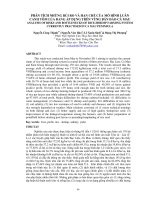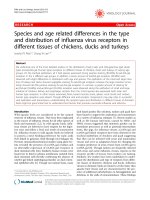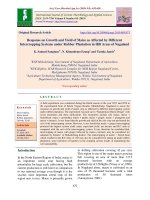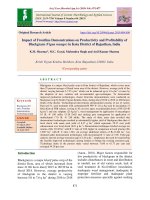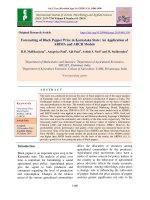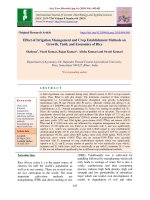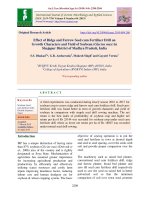Status and distribution of rice grain discolouration in different ecosystems in Karnataka, India
Bạn đang xem bản rút gọn của tài liệu. Xem và tải ngay bản đầy đủ của tài liệu tại đây (387.82 KB, 10 trang )
Int.J.Curr.Microbiol.App.Sci (2020) 9(5): 796-805
International Journal of Current Microbiology and Applied Sciences
ISSN: 2319-7706 Volume 9 Number 5 (2020)
Journal homepage:
Original Research Article
/>
Status and Distribution of Rice Grain Discolouration in Different
Ecosystems in Karnataka, India
B. Pampana Gouda1*, T. Narendrappa1, B. S. Chethana2 and M. K. Prasanna Kumar2
1
KrishiVigyan Kendra, Haradanahally Farm, Chamarajanagara-571127,
University of Agricultural Science, GKVK, Bengaluru, India
2
Department of Plant Pathology, University of Agricultural Science,
GKVK, Bengaluru, India
*Corresponding author
ABSTRACT
Keywords
Grain
discolouration,
Survey, Ecosystem,
Disease incidence,
Severity
Article Info
Accepted:
05 April 2020
Available Online:
10 May 2020
A roving survey was conducted during Kharif 2017 and 2018 in five major rice
growing ecosystems viz., Kabini and Kaveri, Hilly upland, Thungabhadra and
Upper Krishna, Thunga and Bhadra and Coastal belts to know the incidence and
severity of grain discolouration in Karnataka. Grain discolouration was recorded
in all the samples collected from major rice growing ecosystems. The mean per
cent grain discolouration and mean per cent disease index during Kharif 2017 was
12.87 and 12.04 and Kharif 2018 was 13.24 and 12.27 respectively. Both the
years, the maximum percent incidence of disease 14.95 and 15.47 and per cent
disease index 13.64 and 13.94 respectively was observed in Hilly upland followed
by costal belt 14.33 and 15.00 and 13.04 and 13.67 respectively, whereas the least
incidence 11.23 and 11.85 and severity 10.22 and11.03 was noticed in Thunga and
Bhadra ecosystem.
food grain production and continues to play a
vital role in the national food and livelihood
security system.
Introduction
India has a long history of rice cultivation.
Globally, it stands first in rice area (42.41
million ha) and second in rice production
(166.5 million tonnes) (FAO, 2018) after
China. It contributes 21.6 per cent to global
rice production. Within the country, rice
occupies one-quarter of total cropped area,
contributes about 40 to 43 per cent of total
Total area under rice in Karnataka is 1.42
million ha with a production of 3.6 million
tones accounting a productivity of 2.62 tonnes
per ha. The grain yield per unit area is
reducing due to various factors, among which
diseases and abiotic stresses are major causes
796
Int.J.Curr.Microbiol.App.Sci (2020) 9(5): 796-805
for low yield. Rice crop is attacked by more
than 76 fungi, bacteria, viruses and
mycoplasma like organism causing various
diseases in the field. Discolouration has been
observed in almost all part of the world
wherever rice grown. It was earlier considered
to be a minor disease but now gaining more
importance due to its severity in tropical rice
growing areas.
Hilly, Tungabhadra and Krishna, Thunga and
Bhadra, and Costal. To know the incidence
and severity of grain discolouration in
different ecosystem the roving survey has
been carried out during Kharif 2017 and
Kharif 2018.
Materials and Methods
Seed samples were collected through roving
surveys conducted during Kharif 2017 and
Kharif 2018 from farmer’s fields of Mysore,
Mandya,
Chamarajanagara,
Kodagu,
Uttarkannada, Yadagir, Raichur, Koppal,
Bellary,
Shivamogga,
Chikkamagaluru,
Davanagere and Dakshina Kannada districts
representing five rice ecosystem.
The disease is distributed throughout Asia,
Africa and America. In many regions of India,
the early and medium duration rice cultivars
grown particularly in wet seasons are
generally exposed to high humidity and warm
environmental conditions during flowering
and post flowering stages which significantly
favours the disease incidence.
In each district, one or two taluks, in each
taluk, three village and in each village,
three plots were surveyed and are listed in
the Table 1.Randomy 10
representative
panicles from different fields at each location
comprising of cultivars were collected,
labeled and packed in polyethylene bags and
were stored at room temperature (30 ± 2 0C)
for further investigation.
The fungi reported to be associated with
discolouration of grains are Curvularia lunata
(highest 35.30% in Tungabhadra ProjectTBP and Upper Krishna Project-UKP areas of
North Eastern Karnataka), Alternaria
alternate, Fusarium moniliforme, Bipolaris
oryzae, Alternaria padwickii, Pyricularia
oryzae, Fusarium graminareum, Nigrospora
oryzae, Epicoccum nigrum, Phoma sorghina,
Dichotomophthoropsis nymphacearum and
Heterosporium
echinunulatum
etc.
(Sumangala and Patil, 2009a).
The disease was scored by using 0-9 scale
given by IRRI, 2013.
Score
0
1
3
5
7
9
Rice yield loss due to pests and diseases have
been noticed more seriously than ever before.
Grain discolouration is considered as “One of
the most important threats to rice cultivation”
in Karnataka.
The incidence of disease and associated
organisms confined to rice crop, it varies with
environmental conditions viz., and moisture,
temperature, and relative humidity were
prevailing in the location. These factors vary
with one ecosystem to another ecosystem. In
Karnataka, the rice crop is being cultivated in
different ecosystem viz., Kabini and Kaveri,
Description
No symptom of discolouration
Less than 1% discolouration
1 to 5 % discolouration
6 to 25 % discolouration
26 to 50 % discolouration
51 % to 100% discolouration
Per cent disease index was worked out by
using the formula
797
Int.J.Curr.Microbiol.App.Sci (2020) 9(5): 796-805
Grain discolouration (%) was calculated by
using the formula,
and severity of grain discolouration was
observed in all districts. The mean per cent
disease incidence ranged from 10.29 to 15.70
and mean per cent disease index ranged from
8.64 to14.56. The highest per cent grain
discolouration was observed in Kodagu
district (15.70%) followed by Dakshina
Kannada district (14.44%) and least incidence
was noticed in Davanagere district (10.29%).
Results and Discussion
Survey and surveillance studies on grain
discolouration helps to identify the “hot
spot” of grain discolouration disease in rice
from five major rice growing ecosystems of
Karnataka. The roving survey was conducted
to assess incidence and severity of grain
discolouration during Kharif 2017 and 2018
in different taluks of Mysuru, Mandya,
Chamarajanagara, Kodagu, Uttara Kannada,
Yadagir,
Raichur,
Koppal,
Ballari,
Shivamogga, Chikkamagaluru, Davanagere
and Dakshina Kannada districts representing
major five rice ecosystems viz., Kabini and
Kaveri, Hilly upland, Thungabhadra and
Upper Krishna, Thunga, Bhadra and Coastal
belts of Karnataka. The details of farmer’s
field surveyed are presented in Table 1 and 2
and were graded as healthy or discoloured
grains for further examination.
While the disease severity was maximum in
Kodagu district (14.56%) followed by
Dakshina Kannada (13.49%) and least percent
disease index (8.64%) was observed in Ballari
district. The detailed data are presented in
(Table 1,).
Out of 69 villages surveyed, highest incidence
of disease was in Kankanadi village(17.33%)
in Mangaluru taluk followed by in
Mudbidari(16.00%) in Mangaluru taluk,
Hudikeri village in taluk, Bashi village in
Sirsi taluk, Madhuvinahalli village in
Kollegal taluk, Devarahalli village in Maddur
taluk and Basapattana village in Ballari taluk.
The least incidence Mallanayankanakatte
village (8.00%) in Mandya taluk and Kondajji
village in Harihara taluk, whereas highest per
cent disease index (16.29%) in Hudikeri
village in Ponnampet and Kankanadi village
in Mangaluru taluk followed by (14.81%) in
Mudbidari in Mangaluru taluk, Kumata
village in Uttara Kannada,
Basapattana
village in Ballari taluk and Gorebal village in
Sindhanoor taluk. The detailed data are
presented in (Table 1)..
During Kharif 2017, five major rice growing
ecosystems surveyed, the incidence of grain
discolouration and severity of disease was
prevalent in all the five ecosystems with
mean percent disease incidence ranged from
11.23 to 14.95 and mean per cent disease
index ranged from 10.22 to 13.64,
respectively (Table 1, 2, Fig.1). while the,
maximum percent incidence of disease
(14.95%) and per cent disease index (13.64%)
was observed in hilly upland followed by
Costal belt (14.33%) and (13.04%), whereas
the least incidence (11.23%) and severity
(10.22%) was noticed in Thunga and Bhadra
ecosystems. The survey data are presented in
(Table 1, 2, Fig.1). Among 13 districts
surveyed across ecosystems, the incidence
During Kharif 2018, The incidence of grain
discolouration and severity of disease was
prevalent in all five ecosystems with mean
percent incidence ranged from 11.85 to 15.47
and mean per cent disease index ranged from
11.03 to 13.94, respectively (Table 1, 2,
Fig.2). The highest percent incidence
(15.47%) and per cent disease index (13.94%)
798
Int.J.Curr.Microbiol.App.Sci (2020) 9(5): 796-805
was observed in Hilly upland followed by
Costal belt (15.00%) and (13.67%), whereas
the least incidence (11.85%) and severity
(11.03) was noticed in Thunga and Bhadra
ecosystem. The data are presented in (Table 1,
2, Fig.2).
ecosystems surveyed which include 207 fields
form 69 villages of 23 taluks from fifteen
districts of Karnataka. Mean per cent grain
discolouration of 12.87 during kharif 2017
and 13.24 during Kharif 2018 and per cent
disease index of 12.04 during Kharif2017 and
12.27 during Kharif 2018 (Table 2, Fig.1,
Fig.2).
Totally thirteen districts surveyed, the
incidence and severity of grain discolouration
was observed in all districts. The mean per
cent disease incidence ranged from 10.95 to
16.14 and mean per cent disease index ranged
from 10.31 to14.56. The highest per cent
discolouration (16.14%) was observed in
Kodagu district followed by Dakshina
Kannada district (15.23%) and least incidence
was noticed in Davanagere district (10.95%).
These survey results are corroborate with
previous reports from Saifulla (1997) who
reported that grain discolouration of rice was
maximum in hilly region varied from 5 to 50
per cent followed by costal region which
varied from 0 to 50 per cent, whereas in plain
region varied from 0 to 5 per cent during
summer and 0 to 25 per cent in Kharif.
During 1989 and1990, the incidence of rice
grain discolouration was assessed in Bilaspur,
Chamba, Hamirpur, Kangra, Kullu, Mandi,
Sirmour, Solan and Una districts of Himachal
Pradesh. Maximum grain discolouration was
recorded at Rahlu in Kanga district (88.12%)
and least
was in Una district (7.60%)
(Sharma and Vaid, 1990).
While the disease severity was maximum in
Dakshina Kannada district (14.56%) followed
by Kodagu district (14.31%) and least percent
disease index (10.31%) was observed in
Davanagere district and data are presented in
(Table 1, ).
Out of 69 villages surveyed, highest incidence
of disease(17.77%) was in Kankanadi village
in Mangaluru taluk and Srimangala village in
Ponnampet taluk followed by (16.00%) in
Bashi village in Sirsi taluk, Gowdahalli
village in Kollegal taluk, Kumata village in
Uttara Kannada taluk, Suttur village in
Mysuru taluk and Udupi village in Udupi
taluk and least incidence in Kondajji village
in Harihara taluk and highest per cent disease
index (15.55%) in Udupi village in Udupi
taluk followed by (14.81%) in Kundapur
village in Udupi taluk, Kumata village in
Uttara Kannada, Bashi village in Sirsi taluk
and Guttiganur village in Ballari taluk and
least percent disease index (10,31%) was
observed in Agatahalli village in Pandavapur
taluk and Avaraglla village in Davanagere
taluk, and data are presented in (Table 1). The
results from table 3 indicated that, grain
discolouration of rice was prevalent in all five
Rice grain discolouration was found to vary
with variety and Negi and Das (2003)
reported that 18 varieties, Narendra 80 and 97
experienced maximum grain discolouration
(54.7%) and were followed by Narendra 359
(47.4%), Manhar (46.6%), Basmati 385
(45.4%), Saket 4 (45.3%), Phat Dhan 11
(41.2%), Phat Dhan 16 (40.3%), Phat Dhan
12 (39.4%), Improved Sarbati (39.3%),
Improved Indrasan (36.8%), Pant Sugandha
Dhan 15 (35.8%), Jaya (35.7%), Basmati 386
(33.9%), Phat Dhan 10 (31.2%), Taraori
Basmati (30.7%) and Sarjoo 52 (29.2%),
whereas minimum discolouration was
observed in Pusa 44 (27.5%). Imran Arshad et
al., (2009) reported that the grain
discolouration disease of rice is becoming a
serious threat to rice cultivation during Kharif
season as compared to summer season in hilly
area of Pakistan.
799
Int.J.Curr.Microbiol.App.Sci (2020) 9(5): 796-805
Table.1 Incidence of grain discolouration of rice in different ecosystems in Karnataka during Kharif 2017and Kharif 2018
Ecosystems
13.33
12.00
09.33
2017
Per cent
Mean
disease
Diseases
index
Incidence
(PDI)
(%) of
ecosystem
11.85
11.11
10.37
16.00
3
3
District average
Mandya
3
Jaya
IR-64
Holalu
3
Thanu
Mallanayankanakatte
3
BR-2655
KRH-4
Devarahalli
3
BR-2655
Jayakrishna
Doddaarasinakere
3
Alemanegate
Pandavapur
Agatahalli
Alphahalli
Taluks
Villages
No of
fields
Major
varieties
Diseases
Incidence
(%)
Districts
Chamaraj
angar
Yalandur
Y.K.Mole
Yariyuru
Maddur
3
3
3
Kollegal
Madhuvanahalli
3
Gowdalli
Uttamballi
Mandya
Irrigated
Kabini and
Kaveri
Maddur
Mandya
Pandavapura
Mysore
Suttur
Mysore
Basavanapur
Horalawadi
IR-64
MTU-1010
Gangavati
sona
Aman
KRH-4
IR-64
MTU1001
Aman
3
3
MTU1010
BR-2655
3
Aman
3
District average
3
Jyoti
IR-64
3
Gangavati
sona
MTU-1010
3
District average
Mean
per cent
disease
index
(PDI)
Diseases
Incidence
(%)
2018
Per cent
Mean
disease
Diseases
index
Incidence
(PDI)
(%)
10.66
15.55
08.88
11.11
13.33
08.15
12.59
13.33
12.59
13.33
10.66
12.44
12.00
10.66
08.00
14.07
11.11
11.85
12.59
9.63
8.89
16.00
11.10
12.58
11.10
13.33
10.66
14.07
08.89
11.35
08.89
12.59
11.11
16.00
13.33
14.81
11.85
13.33
08.88
11.85
10.37
12.66
10.66
08.00
09.33
11.18
14.66
12.59
11.11
07.40
08.89
10.86
13.33
10.66
15.55
11.11
08.88
11.50
16.00
08.89
13.33
07.40
11.11
10.61
14.07
13.33
12.59
11.10
12.59
10.66
12.88
10.37
12.07
10.66
12.58
08.89
11.85
12.16
800
11.59
12.22
Mean
per cent
disease
index
(PDI)
11.27
Int.J.Curr.Microbiol.App.Sci (2020) 9(5): 796-805
Kodagu
Ponnampet
Hudikeri
Srimangala
Balele
Sirsi
Yedurbail
Bashi
Gudnapur
Hilly upland
Uttara
Kannada
Raichur
Sindhanoor
Irrigated
ecosystem of
TBP
and
UKP
Koppal
Gangavati
Bellari
Yadgiri
Siruguppa
Gorebal
Sindhanoor
Javalagera
Basapattana
Heruru
Anegundi
Siruguppa
B.M.Sugur
Balakundi
Hospete
Kamalapur
Kampli
Ramasagara
Bellari
Emmignur
Guttiganur
Kottal
Shahpur
Hothpete
3
3
3
Jaya
Sona
massuri
Local
District average
3
Jaya
KMP105
3
Abhilash
3
Hemavati
District average
3
BPT-5204
RNR-15048
3
Gangavati
3
Sona
Nellur Sona
Kaveri Sona
District average
3
BPT-5204
Gangavati
3
Sona
3
Nellur Sona
RNR-15048
Kaveri Sona
District average
3
BPT-5204
Gangavati
3
Sona
3
Nellur Sona
Kaveri Sona
3
BPT-5204
RNR-15048
3
Gangavati
3
Sona
Nellur Sona
Kaveri Sona
3
BPT-5204
Gangavati
3
Sona
3
Nellur Sona
Kaveri Sona
District average
3
RNR-15048
16.00
13.33
17.77
16.29
14.7
13.33
16.00
17.77
14.66
16.29
11.85
14.81
15.70
10.66
16.00
13.33
14.56
08.89
14.81
12.59
16.14
10.66
16.00
17.77
14.31
13.33
14.81
12.59
13.33
13.33
12.00
11.33
12.09
14.81
11.85
09.63
14.81
11.10
10.86
13.33
13.57
11.85
11.11
10.89
12.22
16.00
14.66
12.59
12.09
14.81
13.33
11.85
11.76
15.00
11.11
13.33
11.28
13.33
10.89
12.59
14.41
10.66
12.00
13.33
13.33
09.63
12.59
14.81
13.14
11.11
12.00
13.33
12.27
08.89
12.59
11.11
9.33
10.66
13.33
08.89
09.63
12.59
09.33
10.66
11.10
08.89
09.63
08.89
12.00
13.33
12.66
11.85
14.81
12.59
12.00
15.55
08.88
11.85
14.81
07.40
11.88
10.66
11.93
11.85
11.55
09.33
10.45
11.85
801
14.95
11.85
13.64
11.03
15.47
13.94
12.62
12.36
Int.J.Curr.Microbiol.App.Sci (2020) 9(5): 796-805
Shahapur
Gogi
Irrigated
Thunga and
Bhadra
Shivamogga
Chikkamagalu
ru
Davanagere
Shivamogga
Tarikere
Channagiri
Harihara
Davanagere
Coastal
belts
Bellari
Harapanahalli
Uttar Kannada
Uttar Kannada
Dakshina
Kannada
Udupi
Mangaluru
3
3
BPT-5204
12.00
Gangavati
13.33
Sona
Nellur Sona
Kaveri Sona
District average
11.99
Gondhichatttanahall 3
IR-64
09.33
i
BPT-5204
MTU-1000
Harakere
3
12.00
Holaluru
3
10.66
District average
10.66
H.Rangapur
RNR-15048
14.66
Jayashree
Halasur
3
13.33
BPT-5204
Hanne
3
12.00
IR-64 MTU-1010
District average
13.33
Kariganur
RNR-15048
09.33
Jayashree
Kasipur
3
11.33
BPT-5204
Arehalli
3
10.66
IR-64
Nandigavi
3
12.66
MTU-1010
Gondajji
3
08.00
Rajanahalli
3
09.33
Maragondanahlli
3
10.66
Kadlebalu
3
11.33
Avaragolla
3
09.33
District average
10.29
Hiremegalegere
RNR-15048
12.00
Jayashre
Nitur
3
10.66
BPT-5204
Alavagulu
3
09.33
IR-64
District average
10.66
Mundugodu
3
Jaya
12.00
Rasi
Kumata
3
16.00
Intan
Honnavar
3
14.66
District average
14.22
Barkur
3
Kajji Akki
13.33
Intan
Kundapur
3
12.00
Small Jaya
Udapi
3
14.66
Mudbidari
3
Intan dwarf
16.00
Small Jaya
Beltangdi
3
13.33
Kankanadi
3
17.33
District average
14.44
802
12.59
11.85
12.00
15.00
08.89
13.33
12.09
08.89
12.11
11.10
11.35
08.89
11.85
12.59
11.11
12.59
10.66
09.33
12.00
10.66
11.85
11.11
14.66
15.00
12.00
12.59
13.33
11.11
11.10
12.00
10.66
12.66
08.00
13.33
10.66
11.33
08.88
10.66
12.59
08.89
11.85
08.89
11.11
08.89
12.59
07.40
10.66
12.00
11.33
08.89
11.11
12.59
11.33
13.33
16.00
15.00
14.77
14.66
13.33
16.00
15.00
14.66
17.77
15.23
10.86
12.59
14.81
13.33
13.57
12.59
14.81
15.55
13.33
11.11
14.66
14.56
11.85
1.03
10.86
10.66
09.33
08.89
11.85
08.89
09.63
11.85
12.59
08.89
10.28
09.63
08.89
07.40
8.64
10.37
14.81
12.59
12.59
11.33
12.59
13.33
14.81
12.59
16.29
13.49
14.33
13.04
11.85
11.03
15.00
13.67
Int.J.Curr.Microbiol.App.Sci (2020) 9(5): 796-805
Table.2 Incidence of grain discolouration of rice in different ecosystems in Karnataka during Kharif 2 017 and Kharif 2018
2017
Ecosystems
No of
districts
covered
No of
taluks
covered
No of
villages
covered
No of
fields
covered
Major varieties
Irrigated
Kabini and
Kaveri
3
6
18
54
IR-64,MTU1010,Gangavati
sona,Aman,KRH4,Thanu
BR-2655,KRH-4
Hilly
upland
2
Irrigated
ecosystems
of TBP and
UKP
command
4
4
2
6
6
6
18
18
18
54
54
Irrigated
Thunga
and
Bhadra
2
3
9
Diseases
Incidence
(%)
Per cent
disease
index
(PDI)
Diseases
Incidence
(%)
Per cent
disease
index
(PDI)
12.16
11.59
12.22
11.27
13.64
15.47
13.94
12.62
12.36
12.22
11.35
RNR-15048,Jayashree
BPT-5204,IR-64,MTU- 11.23
1010
10.22
11.85
11.03
13.04
15.00
13.67
12.04
13.24
12.27
Jaya,Sona
massuri,Local
14.95
Jaya,KMP105,Abhilash
Hemavati
BPT-5204,RNR-15048
Gangavati Sona,Nellur
Sona
Kaveri Sona
27
Jaya,KMP105,Abhilash 14.33
Hemavati
Coastal
belts
15
23
69
2018
207
Mean Average
803
12.87
Int.J.Curr.Microbiol.App.Sci (2020) 9(5): 796-805
Fig.1 Incidence of grain discolouration of rice in different ecosystem in Karnataka
during Kharif 2017
Fig.2 Incidence of grain discolouration of rice in different ecosystem in Karnataka
during Kharif 2018
Total 287 seed samples consisting of 20
cultivars collected from major rice growing
parts of Tamil Nadu and were used for
analysis of health status. Among them, the per
cent disease incidence ranged from 1.39 to
58.89 per cent. (Gopalakrishnan et al., 2010)
and Sumangala et al., (2010) reported mean
per cent incidence 10.34, 8.69 and 11.27 and
mean per cent index 9.05, 8.39 and 10.70 in
Raichur, Yadgir and Koppal, plain regions of
North Eastern districts of Karnataka,
respectively. The rice grain discolouration
samples were collected from four districts of
Andhra Pradesh. The percentage of
discoloured grains from West Godavari
district samples was ranged from 21.91 to
27.32 on weight basis and from 22.74 to
28.88 on grain number based analysis.
The corresponding percentages were; Krishna
district - 23.02 to 28.62 and 24.34 to 30.35%,
Guntur district - 22.58 to 28.76 and 24.57 to
30.46, and Nellore district - 22.88 to 28.74%
and 25.05 to 30.81% (Divya, 2015).
804
Int.J.Curr.Microbiol.App.Sci (2020) 9(5): 796-805
discolouration disease complex: A new
threat for rice crop and its management.
Pakistan J. Phytopath., 21: 31-36.
IRRI., 2013, Standard Evaluation System for
Rice. IRRI, Manila, Philippines., pp.56.
Negi, H. and Das, B. ( 2003). Screening of
rice varieties against seed discoloration.
Indian Phytopath.,56: 460-461.
Saifulla, M.,(1997). Cause and consequence
of rice grain discoloration rice. M. Sc.
Thesis, Univ. Mys. Karnataka, India. pp
:76-77.
Sharma, O. P.and Vaid, A.(1990). Status and
distribution of grain discolouration
disease of rice in Himachal Pradesh.
Indian Phytopath.,43: 47.
Sumangala, K.and Patil, M.B.(2009a).
Panchagavya- An organic weapon
against Plant Pathogens. J. Pl. Dis. Sci.,
4: 132-135.
Sumangala, K., et al., (2010). Status and
distribution of rice grain discolouration
in north eastern Karnataka. Karnataka
J. Agric. Sci., 23: 804-805.
Acknowledgement
Facilities were provided by Department of
Plant Pathology, GKVK, University of
Agricultural Sciences, Bengaluru and College
of Agriculture, V.C.Farm, Mandya are
acknowledged.
References
Divya, M. (2015). Effect of grain
discoloration complex disease on rice
seed quality and its management, M. Sc.
Thesis, Acharya N.G. rangaAgril. Univ.,
Hyderabad, India.pp: 76-78.
FAO., (2018). Global paddy production and
area.
Food
and
Agriculture
Organization of United Nation., Volume
XXI, Issue No.1. pp.1.
Goplakrishnan, et al., (2010). Survey of seedborne fungi associated with rice seeds in
Tamil Nadu, India. Libyan Agri. Res.
CenterJ. Int.,5: 307-309.
Imran Arshad, et al., (2009). Grain
How to cite this article:
Pampana Gouda. B., T. Narendrappa, B. S. Chethana and Prasanna Kumar. M. K. 2020. Status
and Distribution of Rice Grain Discolouration in Different Ecosystems in Karnataka, India.
Int.J.Curr.Microbiol.App.Sci. 9(05): 796-805. doi: />
805
